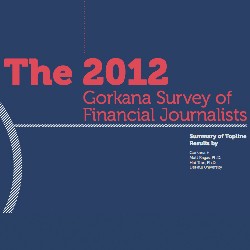A new survey of financial journalists shows that as a whole, they are neutral at best and cautious on their outlook for the U.S. economy and the U.S. financial services sector over the next year.
According to the annual Gorkana 2012 survey of financial journalists, those who work primarily in television/ radio have a significantly more positive outlook on the economy than those who report primarily for the Web, magazines/trade publications, or newswires. Veteran financial journalists have a more positive outlook on the U.S. economy than do journalists with less experience in the field, the survey said.
Gorkana survey’s financial journalists annually to determine how these professionals view the economy, the health of the U.S financial system, the outlook on financial journalism in the country and much more.
The survey was completed in December 2011 and sent out to 3,192 professionals. The organization received 349 responses from business news organizations, compiling and analyzing the data into the presentation given at the 2012 Society of American Business Editors and Writers annual conference in Indianapolis, Ind.
Robert Ingram, the director of Gorkana, and Matt Ragas, Ph.D., an assistant professor at DePaul University presented their report at SABEW’s annual convention in Indianapolis.
“It’s natural for financial journalists to want to see where and how they stack up compared to their peers, and this survey provides one of the first detailed looks into this area,” Ragas said in a prepared statement. “For PR professionals, this is a valuable peek behind the curtain.”
Key findings of the survey include:
Outlook on the Economy: 46 percent of respondents had a neutral view on the economy for the next year, 36 percent had a negative outlook. The data showed that more experienced journalists had more positive views than their less experienced counterparts. Ingram and Ragas speculated that more experienced journalists have been seen the economy bounce back in the past, thus giving them a more positive outlook.
Health of Financial Journalism in the U.S: The majority of respondents had a neutral view of this topic — 44 percent. A smaller percentage, 34 percent, had a positive outlook on financial journalism in the country. The data also showed that more experienced reporters were less optimistic about the field. “Maybe they’ve seen the field change and are not pleased with the changes,” Ingram said.
Most Influential News Organization: A large group, 71.9 percent, said the Wall Street Journal is the most influential financial news organization. Bloomberg news came in second on the survey at 60.1 percent.
Most Influential Financial Journalist: Andrew Ross Sorkin of the New York Times came out on top with 23.9 percent of the vote. Gretchen Morgenson, also from the New York Times, came in second with 21.1 percent. The New York Times dominates this list with half of the journalists in the top ten for this survey.
Sources for Stories: The survey listed many different resources and had respondents give points based on how often they used the listed source. Journalists used the numbers 1-7, 1 being not at all and 7 meaning very often, to provide feedback. The majority, 59.5 percent, said they got story ideas from other publications and readings. Only 5.1 percent said they used corporate social media sites to get ideas, surprising both Ingram and Ragas.
Gorkana provides products and services for public relations specialists and journalists in an effort to better communication in these fields.











